Women’s fascination with fashion, it is known, is irresistible: today, as in the past, designers dictate the new trends in glamour and fashion, enticing the fairer sex to own what is featured in the most eye-catching fashion magazines. While today the creations of fashion designers can be seen on the pages of modern magazines almost solely through photographs, behind which there is a whole world of photographic sets, lighting, makeup and hairdressing, there was a time when it was artists, painters, who depicted in the glamour magazines of the day the fashionable clothes worn by particular models. Because if now to become a model one relies on casting calls, in the past to be depicted in gorgeous gowns were the most famous women of the time: princesses, high society women, but especially women who belonged to the world of show business, such as famous actresses and dancers. Thus a kind of virtuous circle was created: artists collaborated with designers by portraying the latter in magazines (often the portraits were not commissioned by the leading ladies themselves, but rather it was the artist himself who chose the most famous personalities of the moment), and from this all components benefited: the artist had the opportunity to reach many potential clients and to publicize his drawings and paintings through the magazines, while the designers made their creations known and the women of show business promoted themselves to their audience.
One such magazine devoted to fashion was entitled Les Modes, which began publication in January 1901 thanks to the idea of Michel Manzi, an engineer of Italian descent who was a friend of Giovanni Boldini (Ferrara, 1842 - Paris, 1931), Edgar Degas (Paris, 1834 - 1917) and Robert de Montesquiou (Paris, 1855 - Menton, 1921), to celebrate the “most fashionable French and foreign beauties in Paris.” The magazine’s intention was to have the most fashion-conscious artists portray the elegant woman in order to highlight, better than a photograph, the link between female beauty and the beauty of fabric. Manzi decided to have Montesquiou, a poet and aesthete, write the first article in the column Les Peintres de la Femme, paying homage to his friend Boldini: on this occasion he extolled extensively the art of the painter, who by the way a few years earlier, in 1897, had portrayed him with a walking stick in a dandy pose. Painting preserved at the Musée d’Orsay and now on view until June 2, 2019 in Ferrara, at the Palazzo dei Diamanti, where the exhibition Boldini and Fashion is on display.
In the column in the first issue of Les Modes, the poet wrote: "These exclusive artists, as well as sensitive to every form of beauty, are fascinated [...] by the intoxicating flower, complex aroma and multiple seduction, manifestation of the eternal feminine that could be called the universal feminine: the Parisian! Yes, Parisianness, modernity, these are the two words the Ferrarese master wrote on every leaf of his tree of science and grace [...] Modernity, secular sign of time thanks to ornament, what was the string of pearls of a Coëllo, the ruff of a Pourbus, the fold of a Watteau, and what will be the bodice of Boldini." Giovanni Boldini therefore collaborated closely with the great couturiers, such as Worth, Doucet, and Paquin, who adorned the women portrayed by the artist; his paintings, in addition to reproducing the splendid gowns adorned with sequins, veils, tulle, and lace, were a whirlwind of movement, true explosions of lines and color, as is well noted in Firework, a work created between 1892 and 1895 and from the Giovanni Boldini Museum in Ferrara. It is worth noting that many of the works on display come from that very museum: an invitation to explore a fundamental aspect of his artistic production through an exhibition set up in his city of origin.
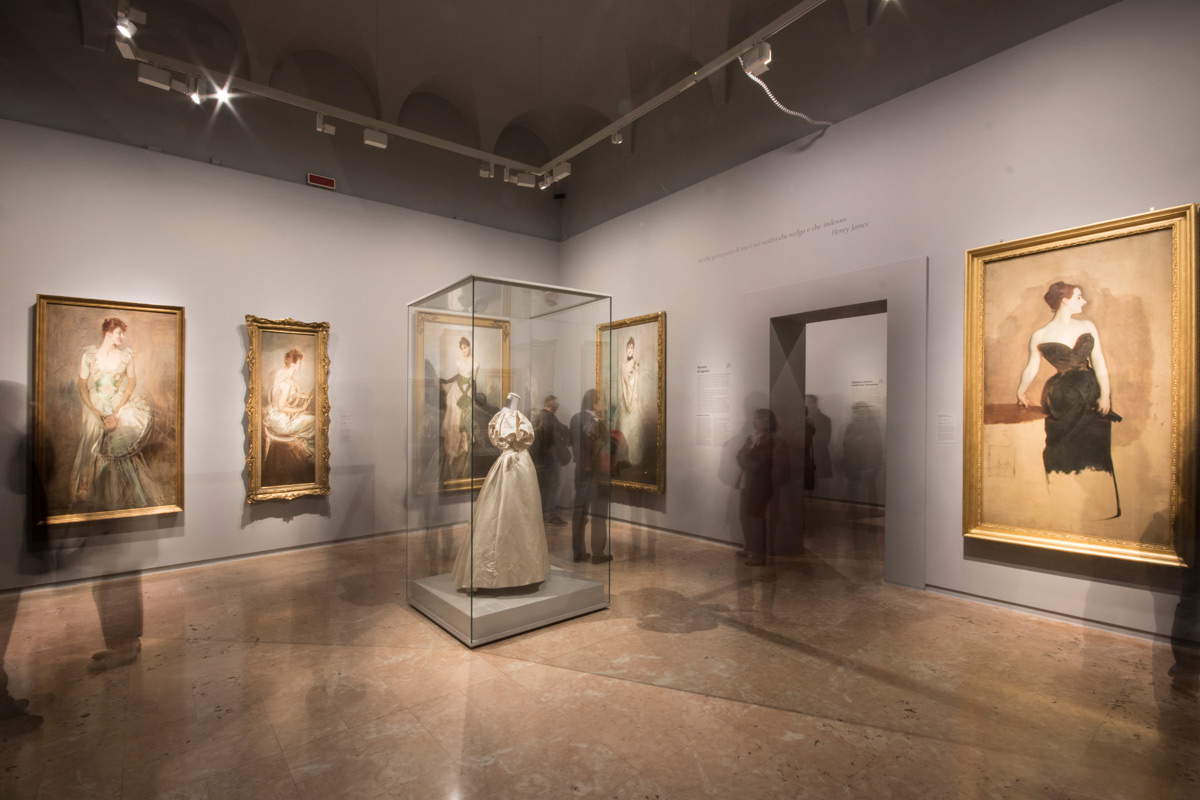 |
| Hall of the exhibition Boldini and fashion |
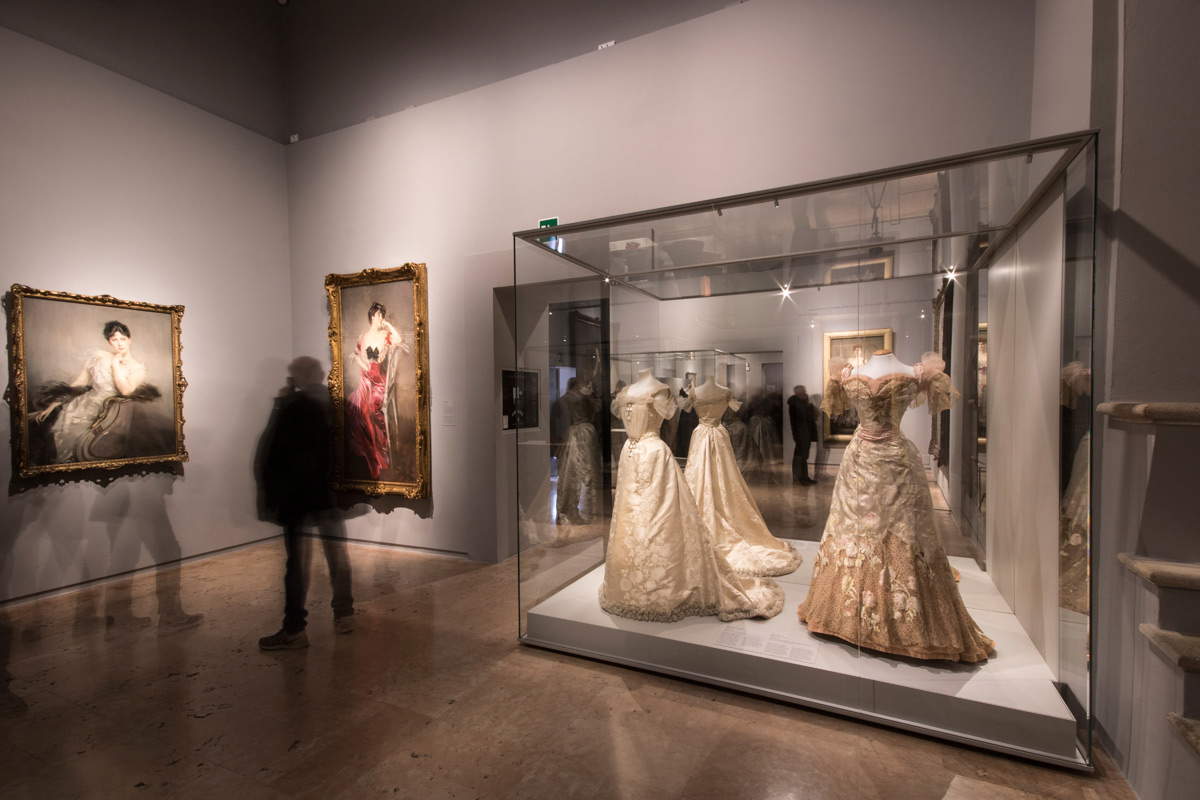 |
| Hall of the exhibition Boldini and fashion |
 |
| Hall of the exhibition Boldini and fashion |
Fulcrum of that modernity referred to by Montesquiou in his writing was certainly Paris in the years between the fin de siècle and the Belle Époque, that is, between the 1880s and World War I. The French capital was the modern metropolis where a profound renewal was taking place both from a social point of view, with the rise ofa new class, whose rise to power was due to economic wellbeing and not to noble origins, and from a cultural point of view, because a slow but progressive emancipation of the female figure was taking place, particularly in the world of entertainment: famous actresses, singers, and dancers had become objects of admiration and emulation. Most importantly, Paris was considered the capital of elegance and fashion, thanks to the rise of couturiers and their ready-made clothes, the spread of fashion magazines, and the birth of department stores. The streets of the metropolis were true open-air catwalks, where people looked and were looked at, a place of constant display of clothes, hairstyle, and makeup. A symbol of emancipation and fashion was the so-called Parisienne : glamorous, seductive, extremely elegant, the Parisienne was the perfect personification of fashion itself, and in the exhibition she is exemplified in the painting by Giuseppe De Nittis (Barletta, 1846 - Saint-Germain-en-Laye, 1884), The Return from the Races, where the woman strolls confidently in the company of her dog, dressed in black and wearing a hat with a veil over her eyes. As will be seen later, black in fact had become an emblem of elegance and refinement, as well as of being fashionable.
The Ferrara exhibition focuses on Boldini’s deep connection with fashion, a remarkably significant component of his pictorial art that accompanied him throughout his production and was also the basis of much criticism of him. Often his depiction of these women, or in some cases little more than little girls, winking, in seductive poses, seemingly natural but actually studied to the smallest detail, with drooping shoulder straps and cleavage, has been interpreted as a painter stopping atappearance, superficiality, painting "a rustling of shimmering fabrics wrapped around voluptuous bodies of women who lose their identity to become simply femme de Boldini," as Albert Flament stated, adding further that the artist limited himself to a serial production; nevertheless, he credited him with great mastery and unparalleled virtuosity in the pictorial execution of his portraits. In reality, however, Boldini through fashion represented not only the taste and fashion of the time, but above all the major changes in the society contemporary to him. In other words, through his portraits he had the opportunity to immortalize on canvas the social and cultural transformations of his time, that is, that modernity so real in the Parisian city that included art, literature, and theater. She captured the fascination of the women of that era with all that was appearance, pageantry, prestige and depicted it in such a modern and effervescent style that it still inspires the creations of some designers, such as Christian Dior, John Galliano, and Alexander McQueen. In fact, the exhibition in question opens with this link between past and present: on one side Boldini’s painting of Madame Charles Max from 1896 and on the other a marvelous embroidered gray tulle dress with nude-colored trompe-l’oeil corset designed by John Galliano in 2005 for Christian Dior.
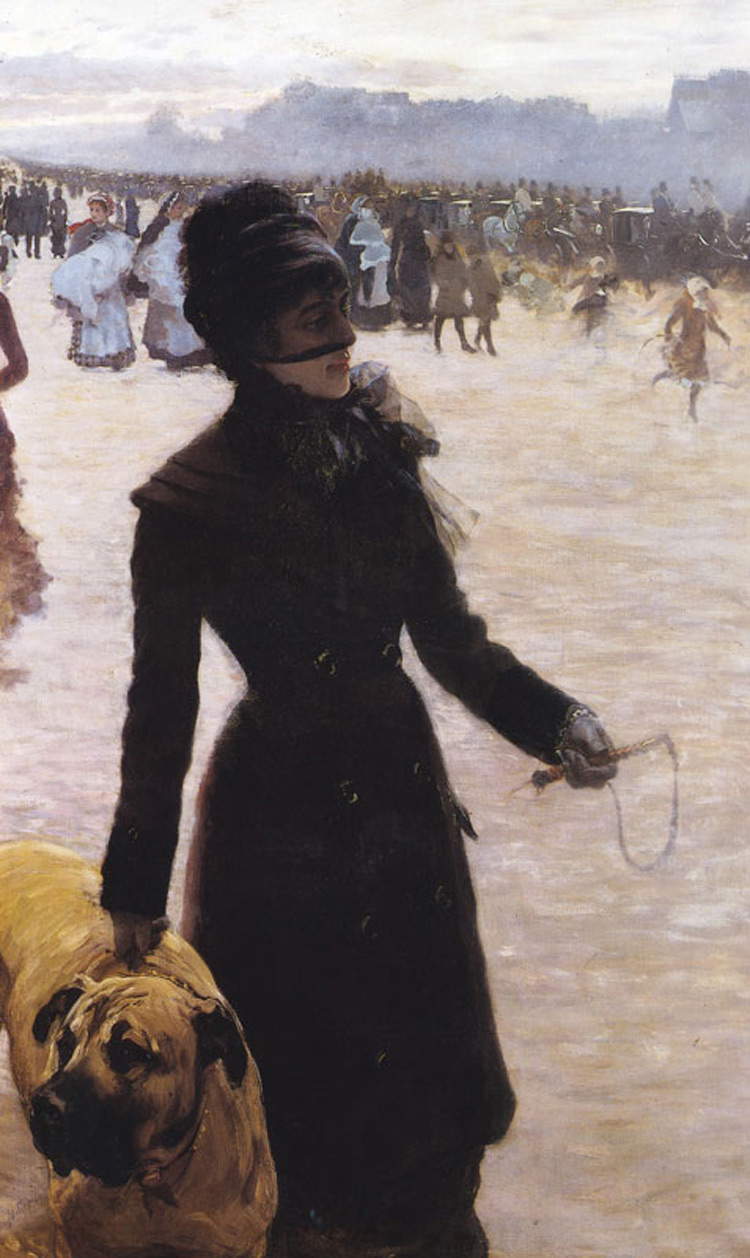 |
| Giuseppe De Nittis, The Return from Racing (1878; oil on canvas, 150 x 90 cm; Trieste, Gallery of Modern Art, Civic Museum Revoltella) |
 |
| Giovanni Boldini, Madame Charles Max (1896; oil on canvas, 205 x 100 cm; Paris, Musée d’Orsay) |
 |
| Boldini and Fashion Exhibition Hall |
The Ferrara exhibition, which is very pleasant and dynamic, is built, as mentioned, on the basis of this intense and inseparable relationship between the artist and fashion, thus juxtaposing Boldini’s portraits with some clothes that in setting resemble those worn by the protagonists of the paintings; each section is then dedicated to a different theme, such as theamazon, the diva, the socialite, the portrait of a lady, and, an aspect that the writer found very interesting and denoting a great multidisciplinarity of thought, to a literary author who in his books recounted society through fashion, just as Boldini did in his portraits. It begins with Charles Baudelaire (Paris, 1821 - 1867), of whom a portrait by ÉdouardManet (Paris, 1832 - 1883) using the etching technique appears in the exhibition. The latter was a friend of Boldini, as was Edgar Degas, both of whom were fascinated by the world of fashion. Baudelaire had also written about fashion, considering it a tool through which to enjoy the particular beauty of a particular era, and dress was for him a symbol of modern life that should be celebrated by art. This initial section of the exhibition therefore focuses on blackdress, reflecting the fact that in the 19th century, the color black in men’s and women’s clothing no longer implied mourning, but on the contrary indicated modernity and elegance. It is possible to notice this in the portrait of Théodore Duret, a collector and supporter ofImpressionism, painted by Manet, who depicted him wearing a hat and walking stick, and in Degas’s Jeantaud, Linet and Lainé , where the artist portrays in an interior three well-dressed young men absorbed in their own thoughts. An elegant woman portrayed in profile and dressed in black, on the other hand, is the protagonist of Boldini’s painting of Cecilia de Madrazo Fortuny, widow of Spanish artist Fortuny i Marsal and mother of future fashion designer Mariano Fortuny. From this portrait it is also possible to see the typical tournure, a substructure used until 1887-88 to support the skirt, which is also present in the blue-colored promenade dress, placed in dialogue with the aforementioned painting. Black was also theamazon dress, a model of which can be seen, flanked by the characteristic saddle designed especially for amazons, since it allowed them to ride while holding both legs on one side, and a work by Boldini depicting actress Alice Regnault galloping to the Bois with a small white dog in tow.
Another literary man who gave dress a significant role in his novels, emphasizing its power, was Henry James (New York, 1843 - London, 1916), particularly in his Portrait of a Lady (the first edition of the famous novel is on display). For the writer, through clothing, it was possible to express a character’s personality or membership in a particular social class. In fact, in this era, elegant clothes were not worn, as they used to be, only by the members of the aristocracy, but also by the new wealthy classes, who relied completely on couturiers, including Worth, Laferrière, Pingat, when they had to face important moments in social life, such as a grand ball. Therefore, it becomes significant to have an artist’s portrait of society, where theoutward appearance of the woman, conceived as aliving work of art, is privileged. Among the artists still seeking affirmation in this field is John Singer Sargent (Florence, 1856 - London, 1925). His Study for Madame Gautreau, still unfinished (the final work is in the Metropolitan Museum of Art, New York), can be seen on display. It was of the American Virginie Avegno, wife of a wealthy French banker, Pierre Gautreau. When the painting was presented at the Salon, it caused a great uproar because of theaudacity, both formal and in content, with which the painter depicted her: provocative elements were in fact the face caught in profile in a haughty attitude, the very low-cut and provocative black dress, a trait further highlighted by the fallen shoulder pad, and the intrinsic sensuality of the mahogany-haired woman.
 |
| �?douard Manet, Théodore Duret (1868; oil on canvas, 46 x 35.5 cm; Paris, Musée d’Art Moderne de la Ville de Paris) |
 |
| Giovanni Boldini, Cecilia de Madrazo Fortuny (1882; oil on canvas, 115 x 69 cm; Bordeaux, Musée des Beaux-Arts) |
 |
| Boldini and fashion exhibition room |
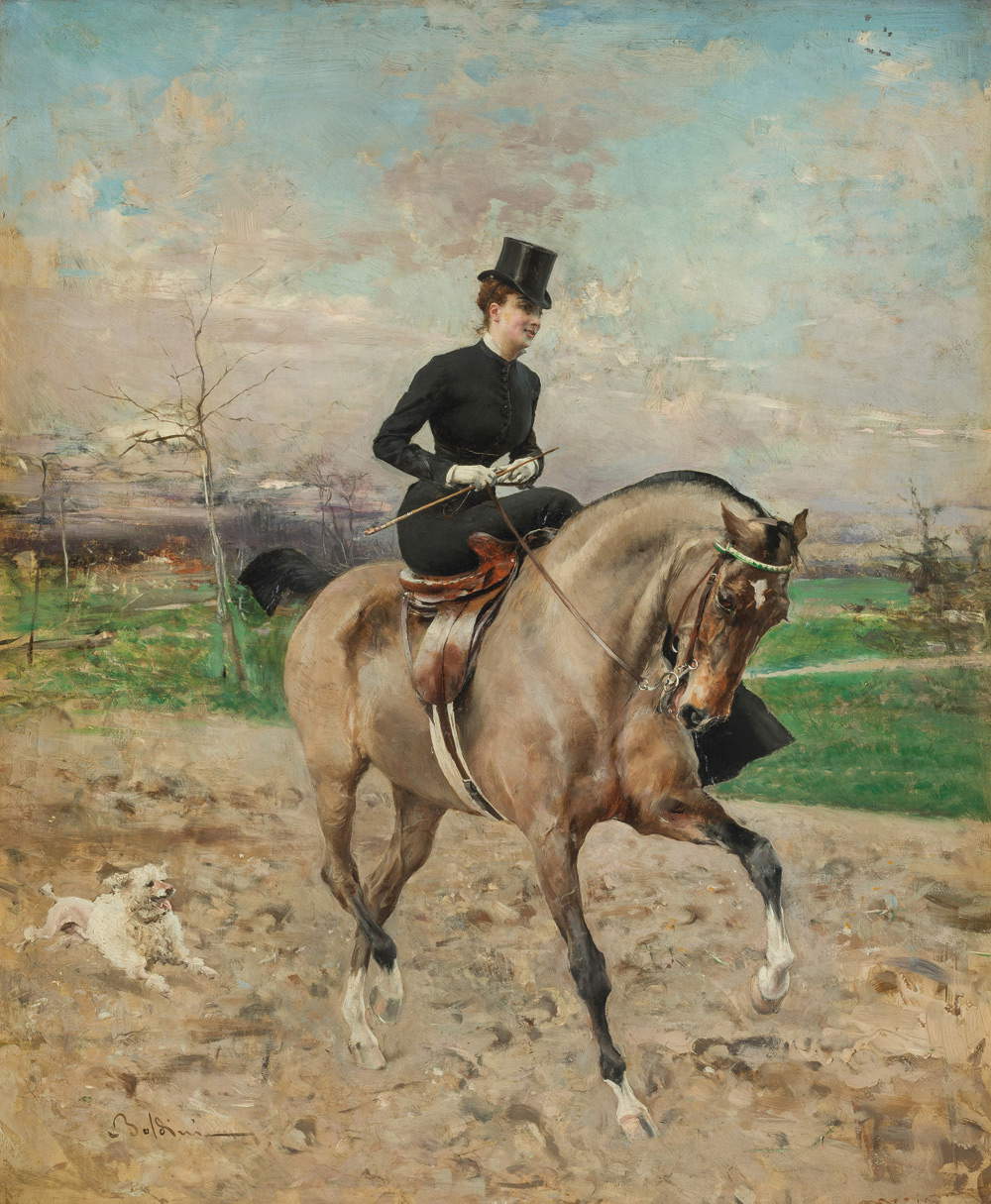 |
| Giovanni Boldini, The Amazon or Alice Regnault on Horseback (ca. 1879-1880; oil on panel, 69 x 59 cm; Milan, Galleria d’Arte Moderna) |
Boldini also portrayed American young ladies: Emiliana Concha de Ossa, the protagonist of the beautiful white pastel, and the latter’s sister in La signorina Concha de Ossa, another pastel in which the maiden clutches a large open fan in her right hand and whose waist is encircled by a long green-colored bowed drape. Both belonged to the family of Chilean consul RámonSubercaseaux. To the sphere of society portraits also belongs the aforementioned painting Firework from the Giovanni Boldini Museum. A brief but vexatious parenthesis devoted to the corset follows: a specimen in satin, silk and lace dating from 1895 - 1905 is accompanied by a drawing by Paul Helleau (Vannes, 1859 - Paris, 1927) with a woman from the back wearing a blue corset and an oil on canvas by Boldini depicting on a seemingly unfinished background the actress Alice Regnault, the same one the artist had painted in an amazonian dress.
Oscar Wilde (Dublin, 1854 - Paris, 1900) is still considered the quintessential dandy writer, the one who madeelegance his life model. The author of The Portrait of Dorian Gray was also editor of the fashion magazine Women’s world, so he was well-connected in the fashionable environment of the time, especially British. In the exhibition, Wilde is referenced for the Reflections section, a title that reminds us that in the late nineteenth century artist and model were accomplices in establishing their public image, as the former chose a specific subject who enjoyed a certain notoriety to enhance his role and the latter chose a famous portrait painter to achieve a specific purpose. Thus three remarkable portraits stand out in this room: Lady Colin Campbell, Robert de Montesquiou, and James Whistler. Three portraits made by Boldini that personify the femme fatale, the dandy, and the artist, respectively. Lady Colin Campbell was one of England’s most prominent women and became notorious for accusing her husband of cheating on her and causing her to contract syphilis, thus initiating divorce proceedings. The elegant and extremely seductive woman is depicted gazing casually at the viewer with a bewitching, penetrating gaze and with her head resting on her arm; she is wearing a beautiful low-cut black evening gown adorned with flowers on her cleavage. The painter James Abbott McNeill Whistler (Lowell, 1834 - London, 1903) is depicted seated presumably in Boldini’s atelier in a pose in which he appears to be waiting to go to a gala evening: he wears a gown with a tuba and the red cockade of the Legion of Honor on his chest. Like Lady Campbell, she looks directly at the viewer and holds her head with her hand. The figure of the dandy is personified, as mentioned earlier, by the intellectual and poet Robert de Montesquiou, a prominent personality who allowed Boldini to come into contact with a wide circle of patrons. Also exhibited in the same room is the portrait of Graham Robertson by John Singer Sargent: the peculiarity of this painting consists in the fact that the real protagonist is not the young man depicted, who also belonged to the dandy circle, but rather the long Chesterfield coat he wears, through which we perceive the social and cultural milieu to which Robertson belongs.
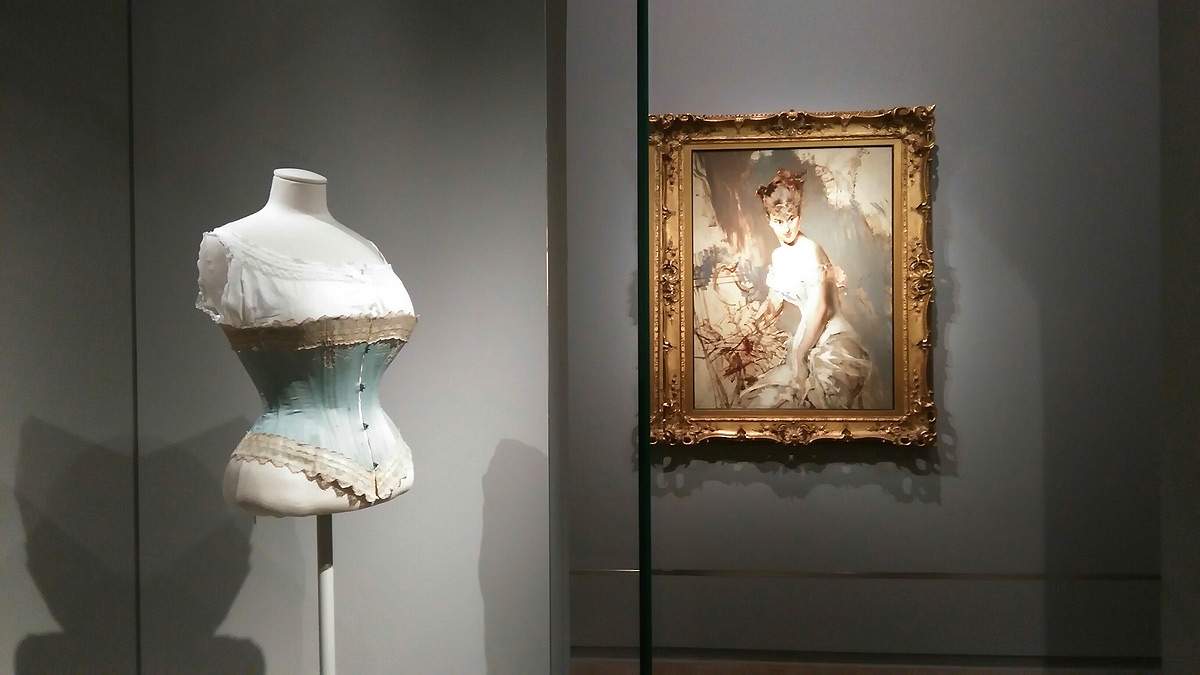 |
| The passage devoted to the corset |
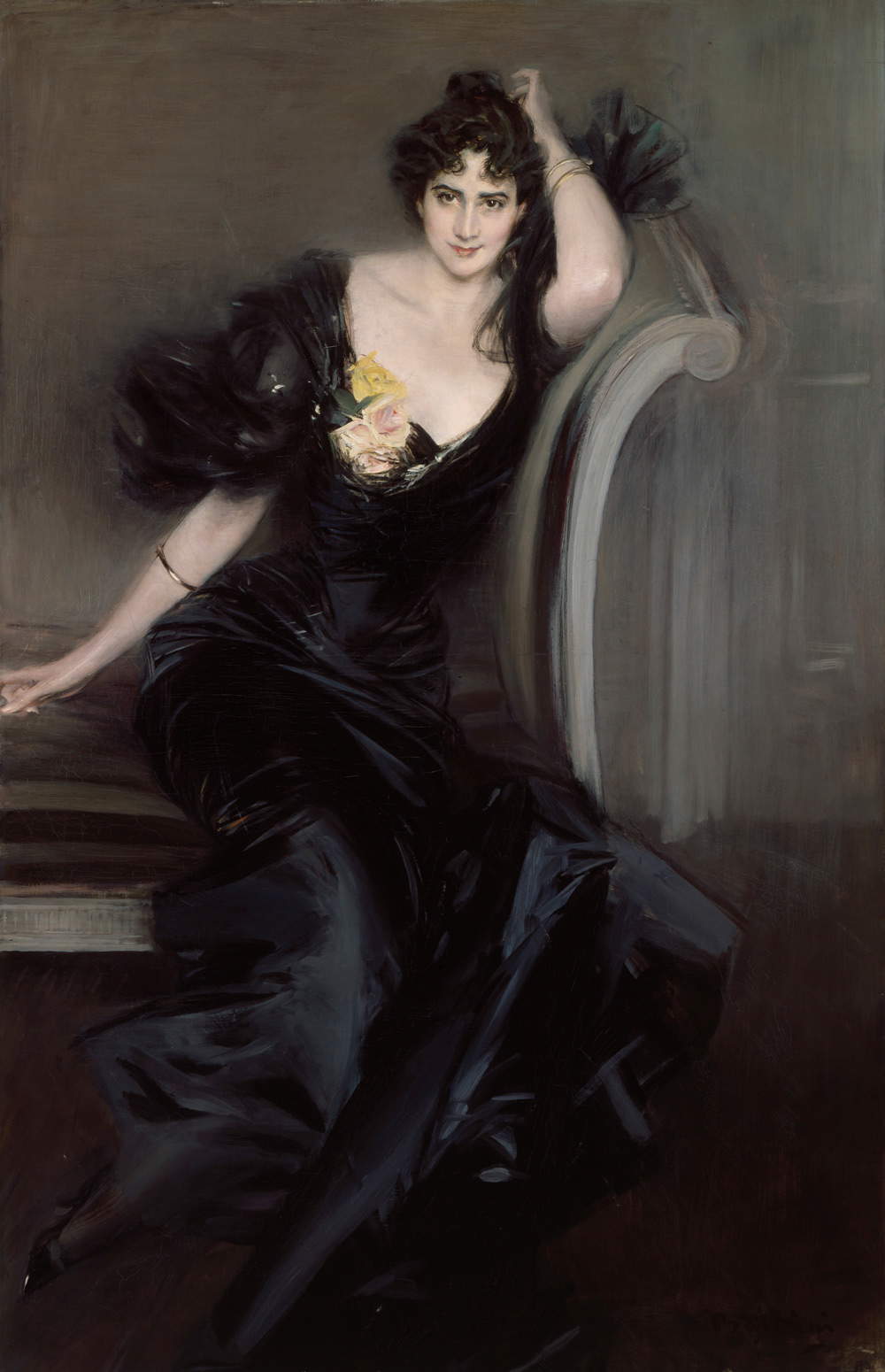 |
| Giovanni Boldini, Gertrude Elizabeth née Boold, Lady Colin Campbell (1894; oil on canvas, 184.3 x 120.2 cm; London, National Portrait Gallery) |
 |
| Giovanni Boldini, Count Robert de Montesquiou-Fézensac (1897; oil on canvas, 115 x 82.5 cm; Paris, Musée d’Orsay) |
 |
| Giovanni Boldini, James Abbott McNeill Whistler (1897; oil on canvas, 170.8 x 94.6 cm; New York, Brooklyn Museum) |
Even in Marcel Proust ’s (Paris, 1871 - 1922) Search for Lost Time, clothing is a significant part: even in order to provide his readers with a fresco of the different characters within the novel, with their attitudes and the various circles they frequented, the writer analyzed that represented society for fifteen years, frequenting those places and those members of contemporary high society himself. Thus, through the pages of the novel one understands the characteristic behavior of the high society of that time and in some cases recognizes renowned personalities of the time: an example of this is the passage in which the Countess Oriane de Guermantes is mentioned wearing a very elegant red evening dress; for this character Proust was inspired by one of the most prominent women in Paris, the Countess ÉlisabethGreffulhe, to whom conspicuous red kidskin and velvet shoes belonged, impossible to miss immediately on display. These particular shoes are placed in dialogue with a splendid portrait created by Boldini, Miss Bell: a young woman depicted in a red dress, seated and absorbed in her thoughts. Within this section of the Ferrara exhibition devoted to worldliness are fascinating portraits of beautiful women, such as the seductive Lady in White, whose painted dress is set against an extraordinary white evening dress that features similar veil ornaments on the shoulders, Princess Eulalia of Spain who wears a refined gown rich in lace, and The Lady in Pink (Olivia Concha de Fontecilla) who wears a sparkling bright pink dress embellished with flowers. However, the great star of this room is the double portrait of Consuelo Vanderbilt, Duchess of Marlborough, with her son preserved at the Metropolitan in New York. The woman’s slender figure, in which her long neck stands out, has been charged by the artist through the device of twisting both the neck and torso and the left arm stretched backward. A monumental painting that captivates the viewer. Also curiously present is the portrait that the Duke of Marlborough himself commissioned Boldini to paint of his mistress and later wife after his divorce from Vanderbilt, Gladys Deacon.
Thanks to the help of Gabriele d’Annunzio (Pescara, 1863 - Gardone Riviera, 1938), an aesthete author and lover of luxury and the superfluous, Boldini met the Marchesa Luisa Casati in Venice: the divine Marchesa depicted in profile in a flurry of brushstrokes stretches her right arm backward and wears a very special headdress made of peacock feathers. The marchesa symbolically closes the exhibition, highlighting how true divas, or divines, become the protagonists in Boldini’s last works: emancipated, seductive, self-confident women who are revered as living works of art. Luisa Casati was indeed very eccentric in her clothes and accessories: she wore zoomorphic jewelry, tiger-skin gloves, panther coats, diamond slippers, woven with silver threads. D’Annunzio also asked D’Annunzio to act as a go-between to portray the Russian actress and ballerina Ida Rubinstein, but the painter probably did not achieve his goal; she can be seen here in a portrait by Antonio de La Gandara (Paris, 1861 - 1917), dressed in white even though he originally wanted to portray her as a warrior.
Typical of these diva portraits were the showy hats of all sizes and adorned often with feathers, beads, from the most varied fabrics: more restrained the one worn by Lina Bilitis depicted with two Pekinese, much larger the one worn by the billionaire Rita Lydig, famous for her endless wardrobe (she owned a collection of more than a hundred and fifty designer shoes), in Boldini’s famous painting The Walk in the Bois de Boulogne: the diva strolls like a queen in the company of her second husband, the English captain Philip Lydig.
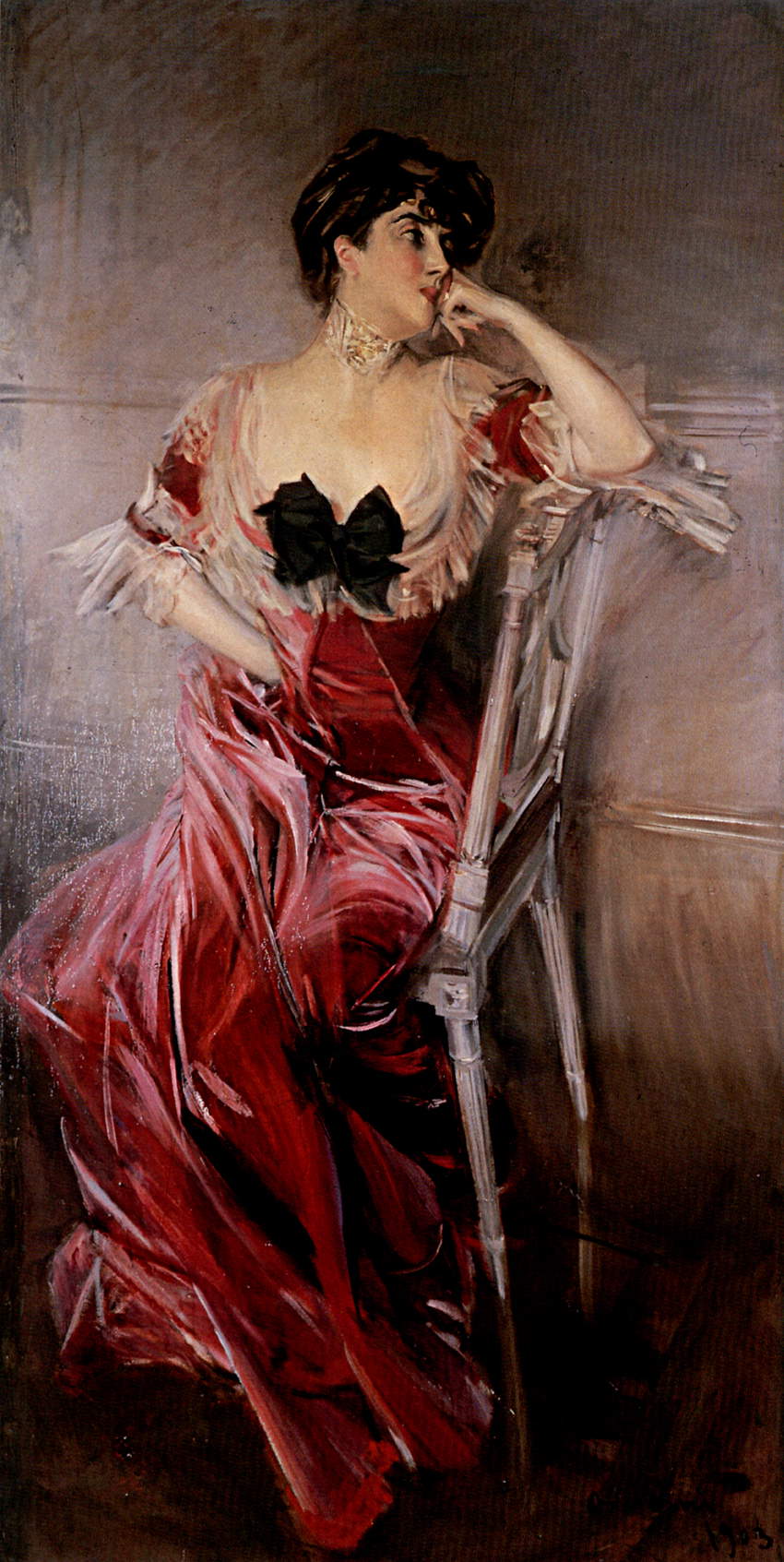 |
| Giovanni Boldini, Miss Bell (1903; oil on canvas, 205 x 101 cm; Genoa, Raccolte Frugone) |
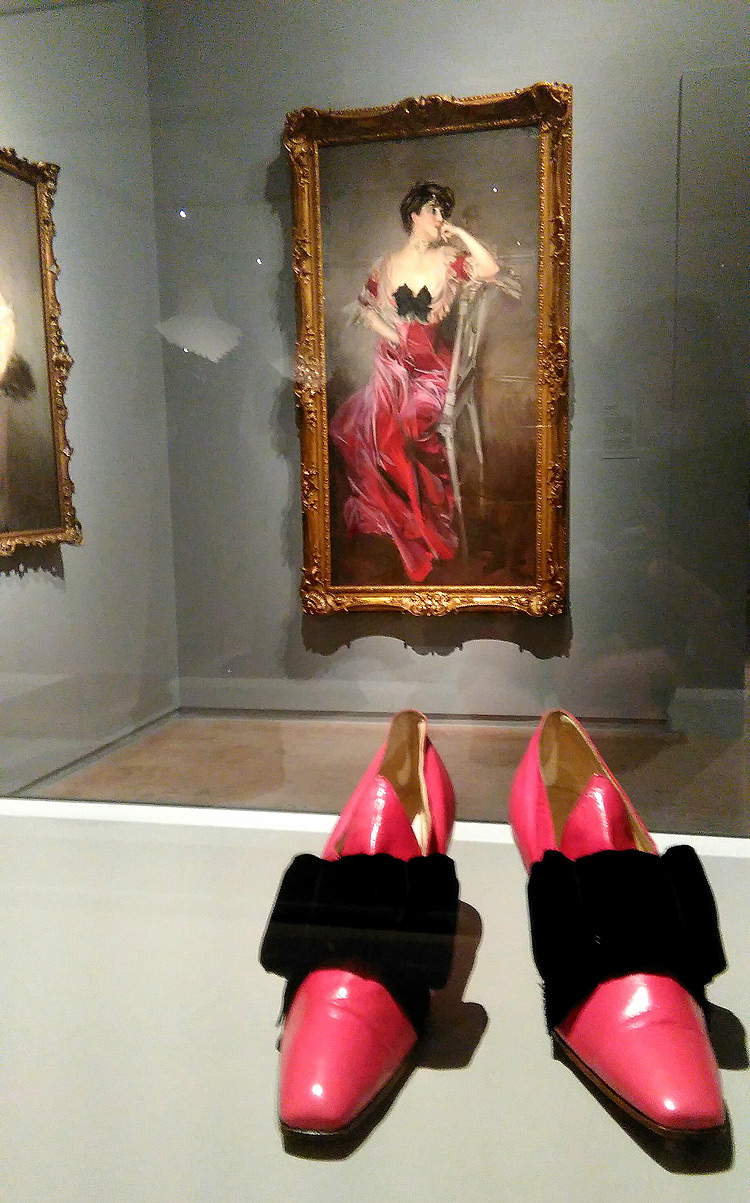 |
| Boldini and fashion exhibition room |
 |
| Giovanni Boldini, The Lady in Pink (Olivia Concha de Fontecilla) (1916; oil on canvas, 163 x 113 cm; Ferrara, Museo Giovanni Boldini) |
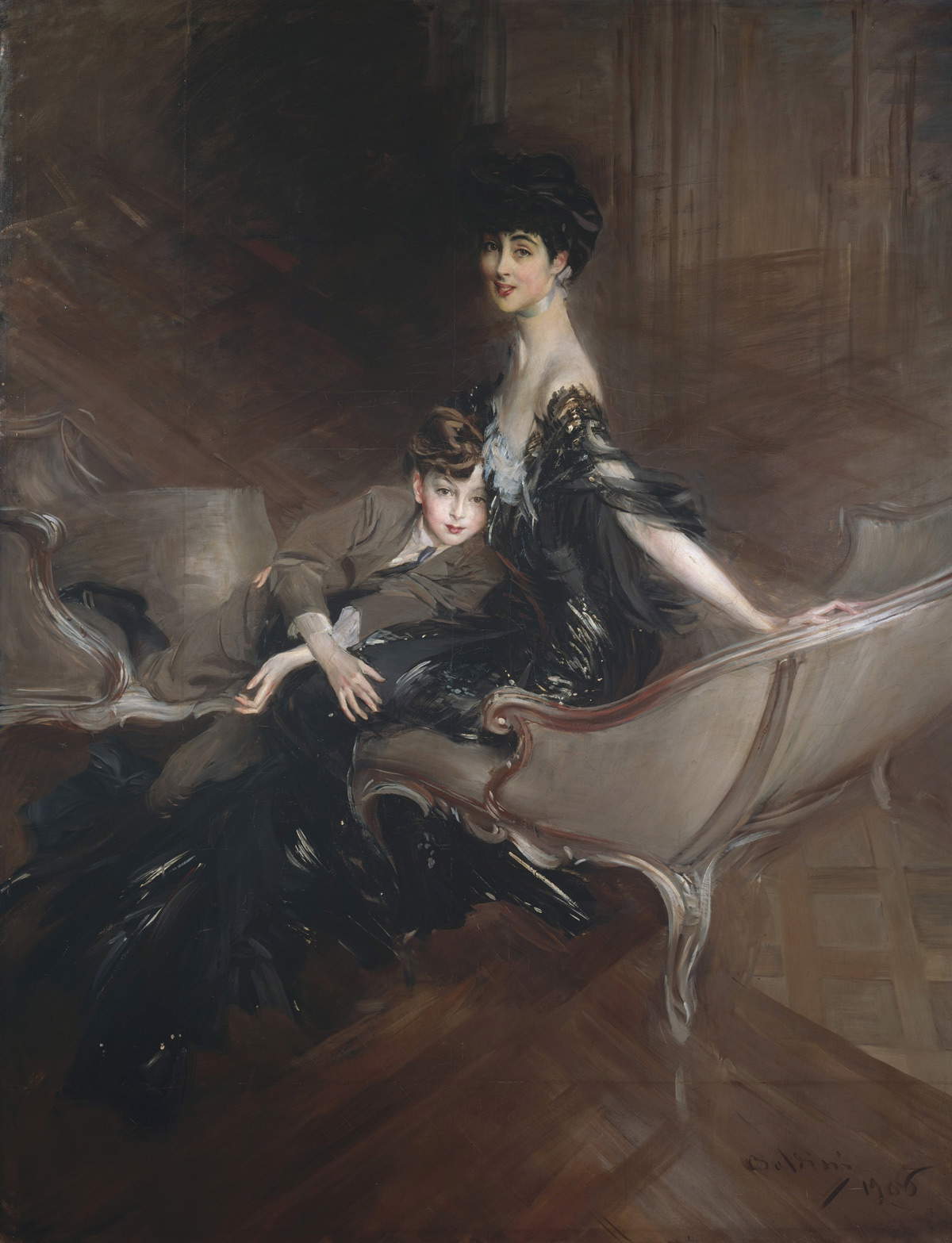 |
| Giovanni Boldini, Consuelo Vanderbilt, Duchess of Marlborough, with her son, Lord Ivor Spencer-Churchill (1906; oil on canvas, 221.6 x 170.2 cm; New York, Metropolitan Museum) |
 |
| Giovanni Boldini, The Walk at the Bois de Boulogne (1909; oil on canvas, 228 x 118 cm; Ferrara, Museo Giovanni Boldini) |
The exhibition is accompanied by an elegant catalog full of images and contributions devoted to the historical and cultural Parisian context in which Boldini is introduced, to the inescapable relationship between fashion and portraiture to which is linked Michele Majer’s in-depth essay recounting the history of the aforementioned Les Modes magazine. Costume historian and exhibition consultant for the choice of clothes Virginia Hill analyzes the style of Parisian haute couture, dwelling on the fashion houses favored by the so-called femmes de Boldini, while more oriented toward contemporary fashion, often inspired by the clothes depicted in the Ferrara painter’s paintings, is Marie Sophie Carron de la Carrière’s essay.
Thanks to this interweaving of art, fashion and literature, the Boldini and Fashion exhibition succeeds in conveying to visitors the world of a near past made up of gentlewomen and gentlemen, of sequins and walking sticks, of gala events and emancipation. A past that also fascinates and inspires in the present. It is a review that enchants and teaches, for this unceasing relationship between Boldini and fashion had hitherto been known but implied; thanks to the expertise and passion of the curator and all those involved in this project, it is now also understood in its intimate significance.
Warning: the translation into English of the original Italian article was created using automatic tools. We undertake to review all articles, but we do not guarantee the total absence of inaccuracies in the translation due to the program. You can find the original by clicking on the ITA button. If you find any mistake,please contact us.